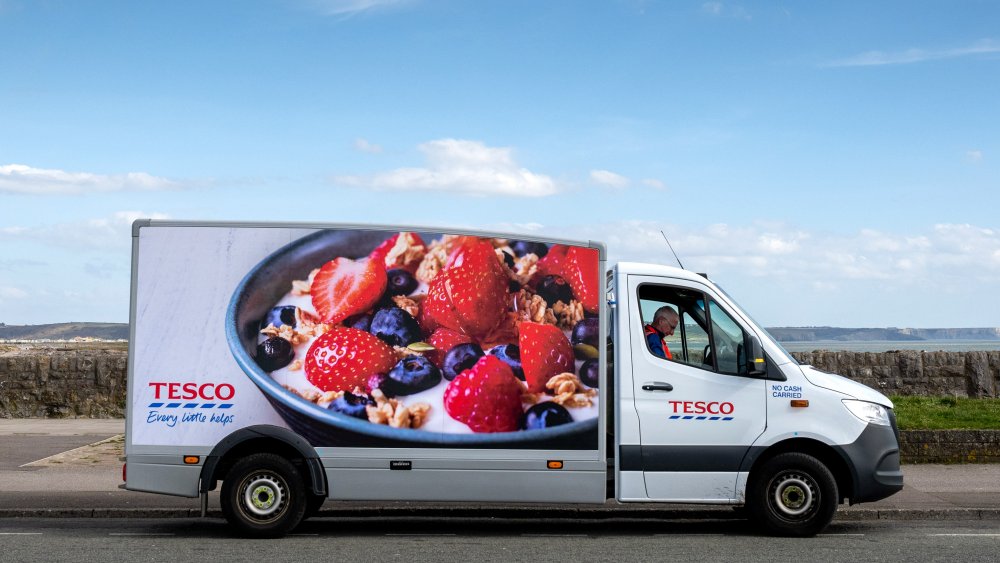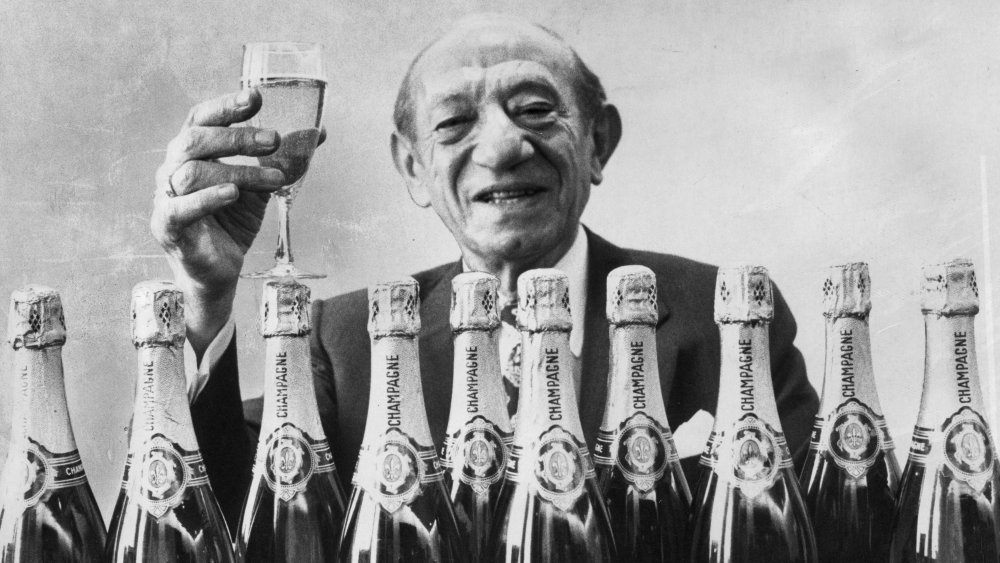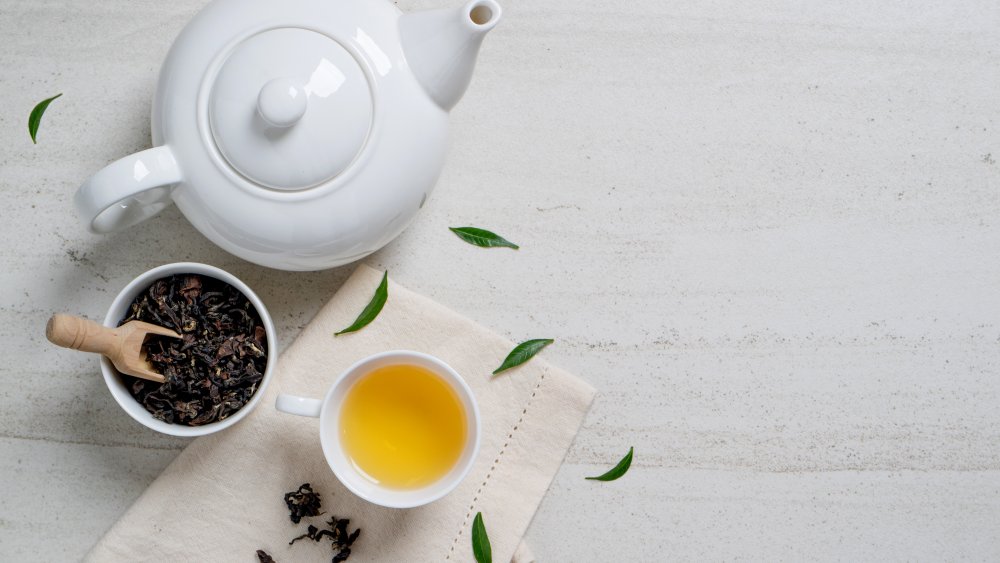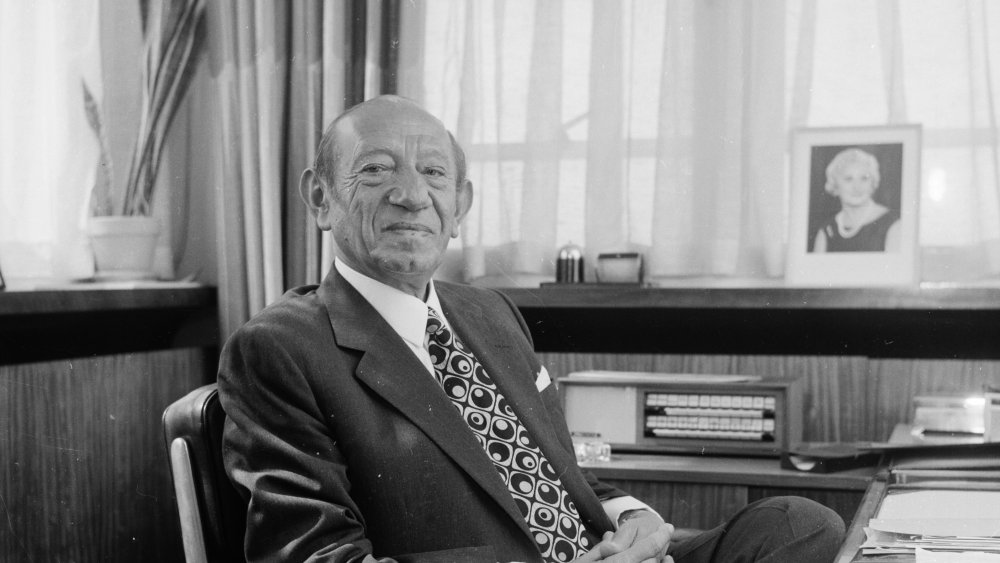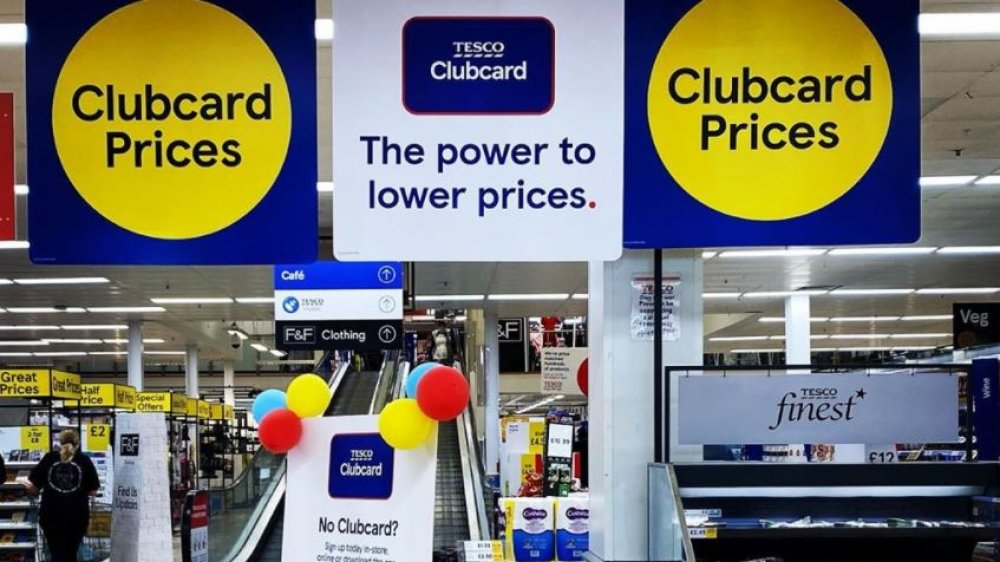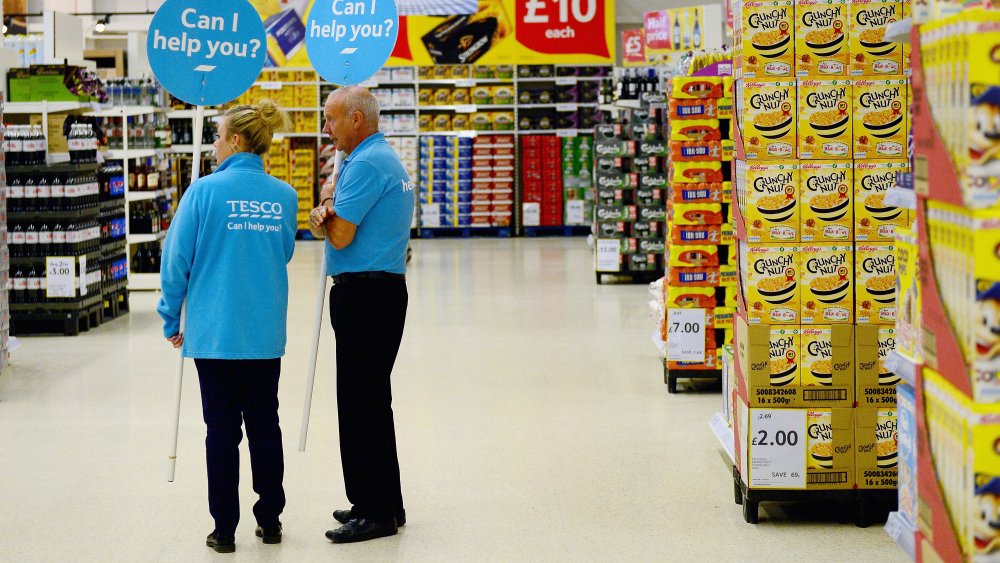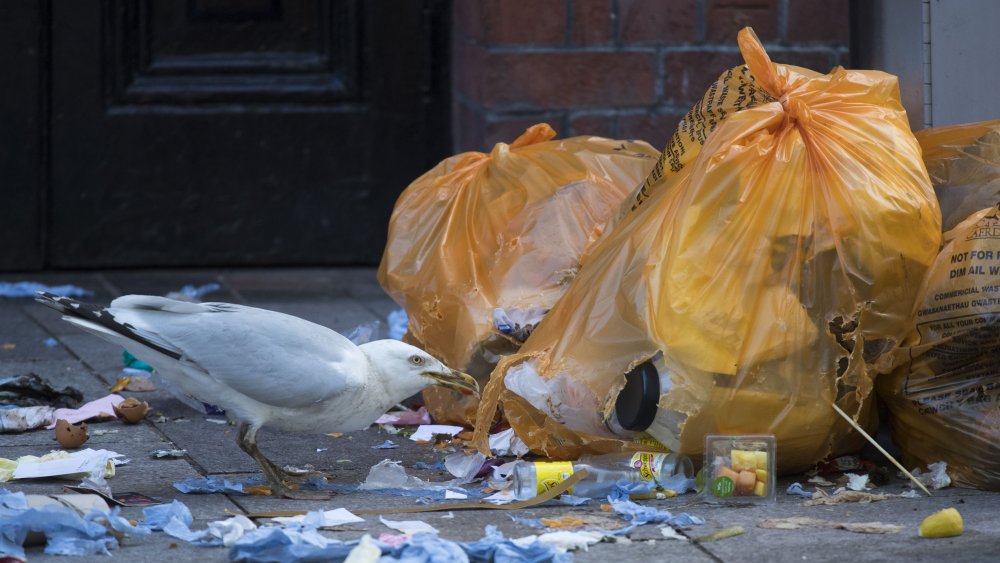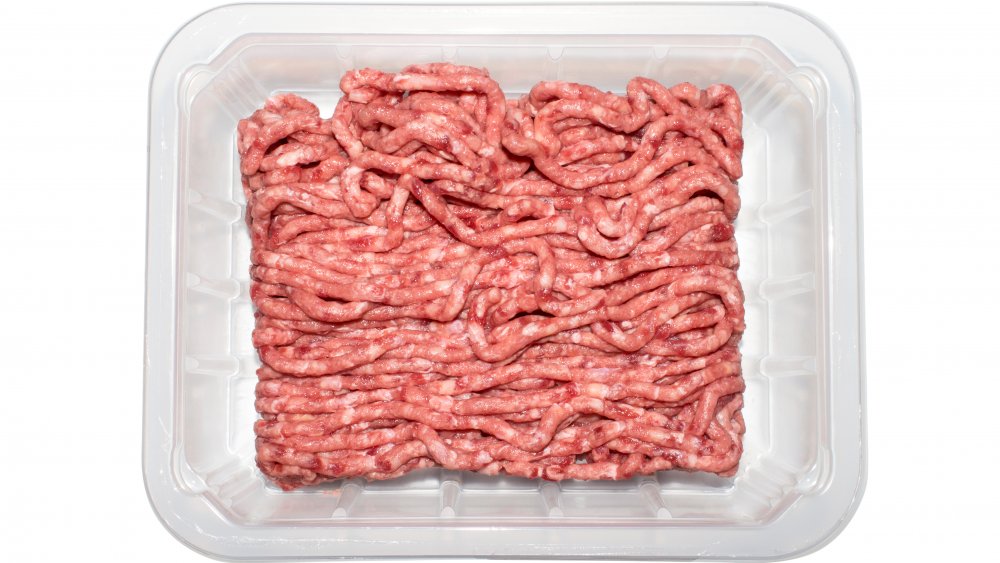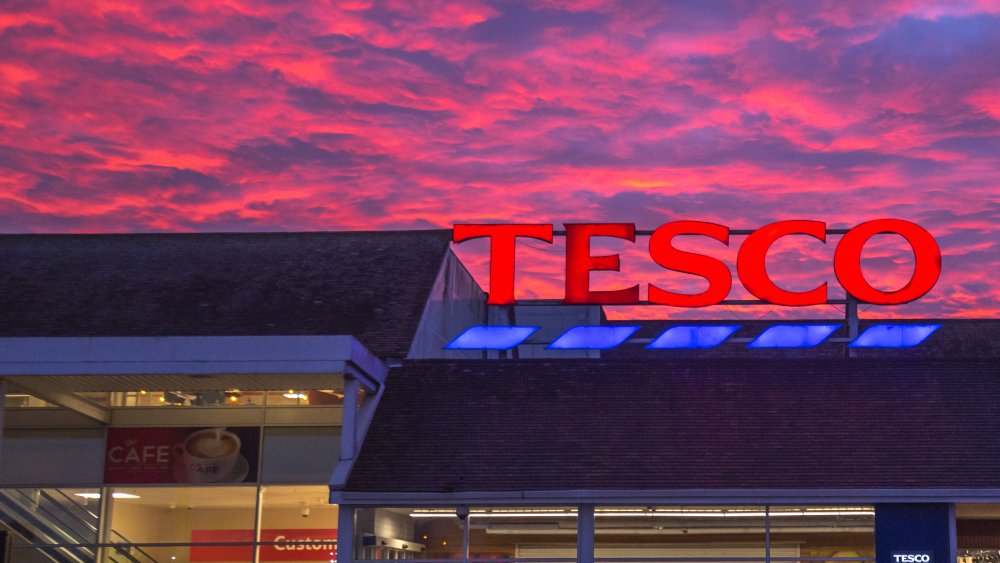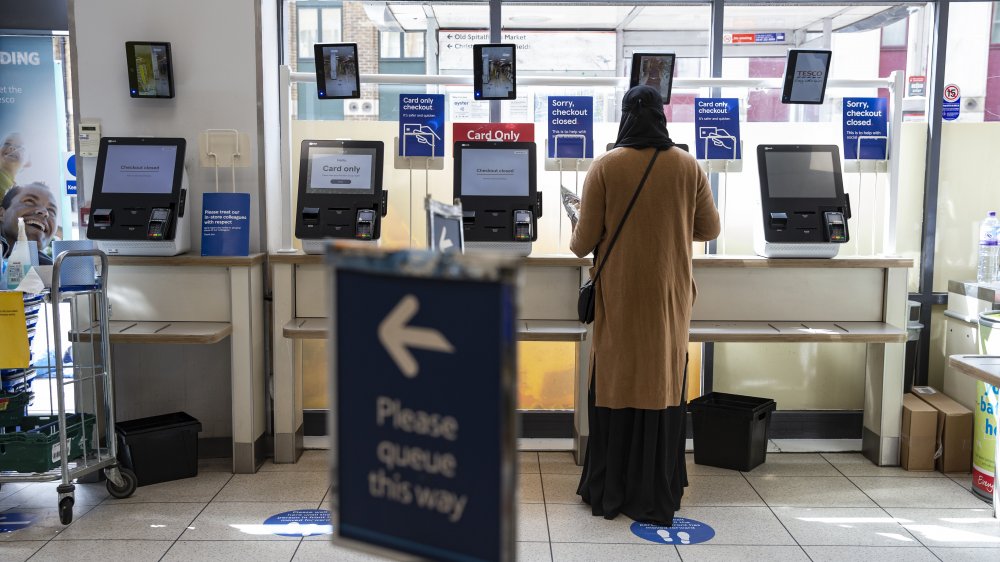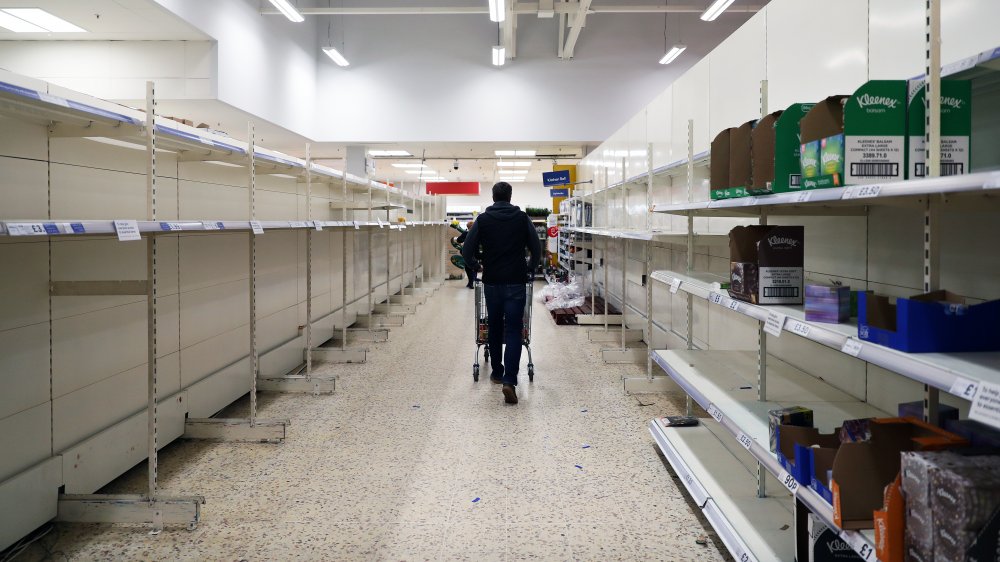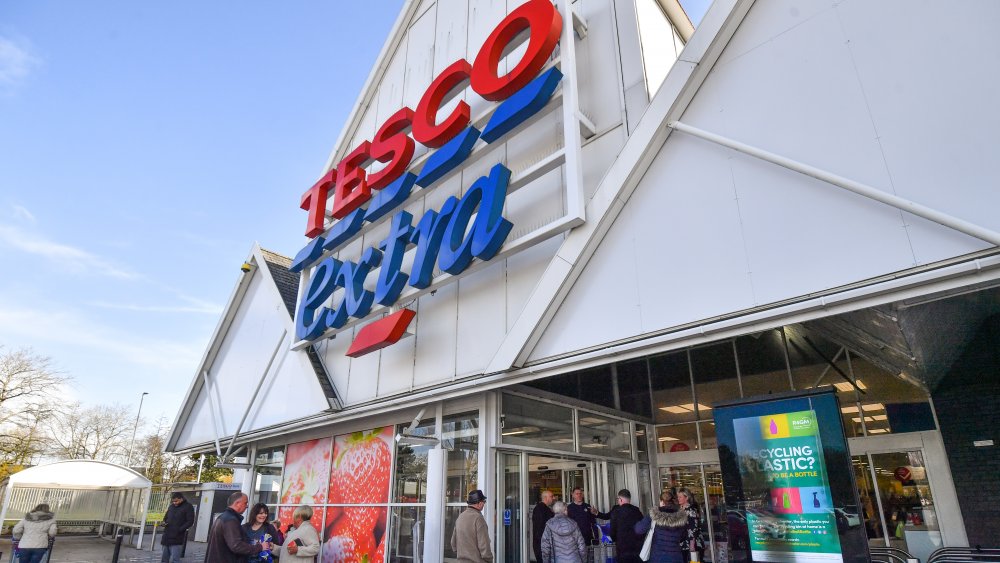The Untold Truth Of Tesco
Although Americans may not be readily familiar with Tesco, it's a household name across the pond. As the world's third-largest supermarket company and the largest one in the United Kingdom, Tesco's annual revenue in 2019 was almost $52 billion. They seem to be doing just fine without a US presence, where Walmart leads the pack.
Tesco operates stores in more than 12 countries across Europe, Asia, and the United Kingdom, providing customers with everything from breakfast to bathroom decorations to flatscreen TVs. First opened in London in the early 1900s, the grocery store now has nearly 4,000 locations in the nation, which provide jobs for over 340,000 Brits. Worldwide, there are about 7,000 stores.
It is often said that, at Tesco's most successful, the supermarket company received one pound in every seven spent in the UK. With that kind of traffic, it's no wonder Tesco has grown to such acclaim.
It all started in London with Jack Cohen
At the end of World War I, Jack Cohen was an ambitious 21-year-old who had just returned from the war. Fresh out of the Royal Flying Corps, he bought a few food items — rumored to be fish paste and golden syrup, according to BBC — from the Army's surplus supply and sold it to make his first profit — about $1.28 today.
Phil Lyon, an Edinburgh historian, said Cohen's success was unique. "Cohen built his business when there was still a lot of austerity around," Lyon commented. "To drive business development of that kind at that time was quite remarkable. He totally understood what worked for the mass market."
Regardless of England's government-mandated spending limits, it didn't take long for Cohen to turn his pocket change into much larger profits. About 10 years after he began selling goods out of a market stall in the East End of London, Cohen was able to open the first-ever Tesco store, located in North London. There, he sold dried goods and the first branded Tesco product (that's still available today!): Tesco Tea.
Tesco tea was one of the company's first products and part of its namesake
If you've ever had a cup of original Tesco tea, you've become part of a decades-long, generations-spanning tradition of loyal Tesco tea drinkers. When Jack Cohen owned and operated Tesco in the nascent days of the company's existence, he sold stock items he bought from other companies. But five years after starting out, Cohen began selling a product made especially for his self-operated market stall.
Tea, a product that enjoys widespread popularity in England, was not only Tesco's first branded product, but also the reason for its name. Cohen created a name for both his tea and, eventually, his store, by using the first three letters of the supplier from whom he bought the tea itself, T. E. Stockwell, and the first two letters of his name. And so, Tesco tea, and the massive company that followed, was born.
Jack Cohen, the Tesco founder, was nicknamed "Slasher"
Nicknamed "Slasher Jack," or "Guv'nor" to his staff, Jack Cohen was the mastermind behind the Tesco brand from the very beginning. In 1919, Cohen unloaded a wheelbarrow full of food products into a stall at a marketplace in Hackney, London.
Cohen was a "magnetic character," according to Lord MacLaurin, a former Tesco Chief Executive. His "signature" tie pin was engraved with the letters YCDBSOYA, which he, with a cheeky smile, would inform people meant, "You Can't Do Business Sitting On Your Ass."
"Salesmanship, showmanship, call it what you like. You gotta keep this going all the time; every week there must be something special, something new," Cohen said.
On the night of March 24, 1979, at the age of 80, Cohen died. Earlier that same day, MacLaurin had taken Cohen out to visit one of the brand new Tesco Superstores. Cohen was moved to tears. "I never thought I'd see anything like this," he said.
The start of Tesco Clubcards
In 1995, Tesco introduced the Clubcard, a loyalty card that allowed the company to customize shoppers' experience. Many have credited this move to Tesco's overwhelming success at the turn of the century. Before the Clubcard was released, Tesco was in third place amongst British supermarkets; twenty years later, Tesco had doubled the earnings of their next-closest rival.
"I knew the whole industry's structure would never be the same again," Sir Terry Leahy, a former Tesco chief executive, told the BBC. The Clubcard changed not just Tesco, but grocery stores across the country and around the world. While other companies had utilized loyalty cards in the past, they had not done so by using the new data technologies of the digital age. By collecting customer data, Tesco could analyze trends and adjust their business strategy to quickly respond to consumer demand. Leahy claimed that it was these loyalty cards that most significantly led the company to success. It was only in one year from the Clubcard roll-out that Tesco became the UK's top supermarket.
Tesco sells a little bit of everything
If you're wondering what, exactly, Tesco sells, the answer could take a while. Tesco started out as a grocery store, its shelves stocked with food products. In 1974, the supermarket branched out and opened its first gas station, quickly becoming the largest privately-owned gasoline company in the UK.
In the '90s, Tesco diversified even further, becoming the all-purpose store it is today. In addition to food, drink, and gasoline, Tesco also sells electronics and clothes; it is a bank where you can take out loans and buy insurance; the store even offers fitness and education programs for employees.
In 2010, the company introduced its first drive-through store, offering customers the option to do their grocery shopping in the comfort of their cars. Instead of wandering the aisles of a Tesco, you can wander them virtually — just click to order your items online and select a pick-up time. Before you know it, your groceries will be packed into your car and you'll be on your way. This "offers a solution to parents who want to avoid the challenge of shopping in a busy store with children in tow but can't afford the time to stay in for the shop to arrive at their door,"Laura Wade-Gery, chief executive of Tesco.com and Tesco Direct, told the Guardian.
Tesco was criticized for wasting absurd amounts of food
In 2013, Tesco wasted approximately 28,500 tons of food in just six months, causing outrage amongst anti-hunger advocates like Oxfam. Many of England's top supermarkets already had waste reduction strategies in place, making it clear that Tesco's negligence was avoidable.
The head of Oxford's economic justice policy called the situation "nothing short of a scandal," considering the astronomical amount of hungry and impoverished people around the world. "It is a damning indictment of a food system that places greater importance on corporate profits than ensuring everyone has enough to eat," she said.
Since then, Tesco has made an effort to resolve these shortcomings, claiming their "commitment to lead on reducing food waste globally" on their website. As the company continues to grow, however, so does the amount of food that comes in and out of their stores. In 2019 through 2020, the company increased the amount of surplus food they redistributed by 12% compared to the previous year and 82% compared to 2017 and 2018. "As a retailer, we know perfectly matching supply and demand is almost impossible, there will always be some unsold food at the end of each day," their website explains. Still, that surplus food amounted to a whopping 77,807 tons, 36,843 of which — under half — the company gave to charities, community groups, and other organizations that reuse the products.
Horse meat was once found in several Tesco products
What's the last thing you unexpectedly want to find in your frozen dinner? "Mystery meat" likely tops the list. In 2013, two Romanian slaughterhouses were accused of selling contaminated meat to several supermarket chains in various European countries. Irish food inspectors reported to have found horse meat in Tesco burgers, and one brand of frozen beef lasagna contained up to 100% horse meat.
The scandal wasn't necessarily Tesco's fault, and after the incident, Tesco dropped the supplier who sold them the meat and implemented DNA testing to ensure their animal products no longer contained the wrong animals. Tesco's Tim Smith explained this decision to BBC, saying, "Tesco is responsible for the food we sell, so it is not enough to just stop using the supplier."
Tesco apologized profusely to consumers, but after unknowingly eating 29% horse burgers, people had a hard time returning to the company. Tesco's value plummeted, and the supermarket lost well over $300 million because of the affair. Still, it would take a while for the company to convince its customers of their top-quality foods and vendors after such a breach of trust.
Tesco is the UK's largest retailer
In the United Kingdom, Tesco reigns supreme among other popular grocery stores in the nation. As of December 2019, there were 3,961 Tesco stores in England and Ireland, making it the most prolific supermarket in the area by a long shot. Another popular grocery chain, Sainsbury's, trails far behind at 1,428 stores, and Asda is even further at just 631 stores in the country.
Tesco holds a similarly strong lead in market shares with 27.8% dominance compared to the 15.8% and 15.3% Sainsbury's and Asda hold, respectively. Tesco employs over 423,000 workers across their stores and pays them just enough to maintain a £1.54 billion yearly profit ($ 1.96 billion in the United States).
Tesco has expanded since its London infancy, and the grocery giant now operates stores in the Czech Republic, Hungary, and Slovakia. The British chain was even in Thailand and Malaysia until those outposts were sold in 2020. Worldwide, the supermarket sells groceries at 6,993 locations.
Tesco hasn't had success in the US
Despite Tesco's popularity in the UK, the supermarket giant hasn't been able to find its footing on American soil. In 2007, the first US Tesco store opened in Los Angeles, and shortly after, several others were built in the Southwest corner of the country. Tesco planned to expand further into Western cities that lacked easy access to nutritious food, but, due to the economic crisis of 2008, the company never quite flourished in these areas. Whereas they had meant to cater to working-class families, their "Fresh & Easy" offerings seemed better suited to upper-middle class consumers who would find their roof-based solar panels and hybrid car parking spots appealing.
Tesco adjusted their business model several times to appeal to US consumers, but it seemed Americans wanted to stick to their Walmarts and Krogers. Business analysts suggested that there were a number of possible reasons for the supermarket's US failure: Tesco stores are much smaller than most Americans are accustomed to, and its shrink-wrapped packages were an anomaly for US shoppers. "It seemed Tesco understood instinctively that when you open stores in China or Poland those stores are going to have to be different from the British stores," retail expert Jim Prevor said. "They made the fatal mistake of thinking, 'We know what Americans want.'"
Though grocery stores are full of self-checkout stands now, in 2007, Tesco was one of the first stores to introduce them to the United States, and apparently, Americans weren't ready to go without their checkout clerks. In 2013, Tesco left the country for good.
After years of incredible profits, Tesco hit some turbulence in 2014
In 2014 and 2015, the momentum Tesco had gained thanks to its inexpensive products and data-driven loyalty card came to an abrupt halt. The store's market value crashed so significantly it set a record for the biggest loss in the UK's history.
The Tesco company was at the center of an accounting scandal in 2014, which cost Tesco £263 million (or $337 million in the United States) and forced the then-CEO to step down. Philip Clarke was blamed for a dramatic loss in profits during his three-year tenure. Despite his efforts to modernize stores, Tesco's market share dropped from 30.3% to 28.9% when Clarke was in charge. "There will be no tears being shed for him at Tesco," said an anonymous insider who claimed that Clarke was difficult to work for.
But after Clarke left the company, Tesco's financial situation grew worse. In September of 2014, the supermarket chain admitted to overstating their profits by £250 million (about $321 million), causing its share price to drop £2 billion (about $2.5 billion) in a single day. Three Tesco higher-ups were tried for fraud — as the prosecution put it, they "cooked the books." In the end, though, all three men were acquitted of all charges. Still, it was a period in which their was major job loss at home and overseas for Tesco employees and managers, as 43 stores were closed in a turnaround plan.
Tesco has five different store formats
Tesco is a universally recognized name in the UK, but there are several different kinds of Tesco stores, each slightly different from the next. Tesco Express stores are the smallest of them all, each around 3,000 square feet with a limited selection of Tesco's usual grocery options. These shops are similar to corner stores: small spaces for quick snack stops. They first opened in 1994 and now Tesco has a total of 1,713 of these mini-stores.
Tesco Metros are named after their location: most of these stores are in city centers, created specifically for busy city-dwellers. People can purchase to-go sandwiches and other prepackaged meals at Tesco Metro on their lunch breaks. These first opened in 1992 and can be up to 15,000 square feet large.
Tesco Superstores are even bigger, at 20,000 to 50,000 square feet. First opened in the 1970s, here, you can buy not just groceries, but electronics and books too. Extra stores are similar but even larger at 60,000 square feet on average. These opened in 1997, with the intent to meet "one-stop-shop" needs. They have a wider range of items, from groceries and electronics to housewares, clothing, and beauty products.
One Stop shops are owned by the Tesco company but are the only store without "Tesco" in the name. There are 900 shops in England and Wales that offer quick to-go snacks and groceries, as well as post office, lottery, and cash withdrawal services. However, as of January 2020, Tesco is making an effort to rebrand some of their One Stops to Tesco Express, in an effort to cash in one some name recognition.
Tesco plans to go carbon neutral by 2050
In 2010, Tesco opened its first zero carbon store in Cambridgeshire, England. As a whole, the company produces around 4 million tons of carbon per year, so their goal is to go completely carbon neutral by 2050. For a chain with that much of a footprint, it's a commendable and necessary goal. With its biofuels, skylights, and energy-efficient refrigerators, this store is a fully functional Tesco, proving "that you can dramatically alter how much carbon you use and life can go on," as then-chief executive Terry Leahy told the Guardian.
Though the store cost more to build initially, the amount of energy it saves makes up for its price tag. Tesco plans to spend an additional £100 million (or over $128 million) on green technology businesses in the future.
The director of implementation at Carbon Trust, Myles McCarthy, praised Tesco for their dedication to sustainability and commitment to the UN's Paris Climate Agreement goals. "Tesco deserves real credit for being the first corporate to publicly commit to align with a high ambition 1.5C target," he said.
